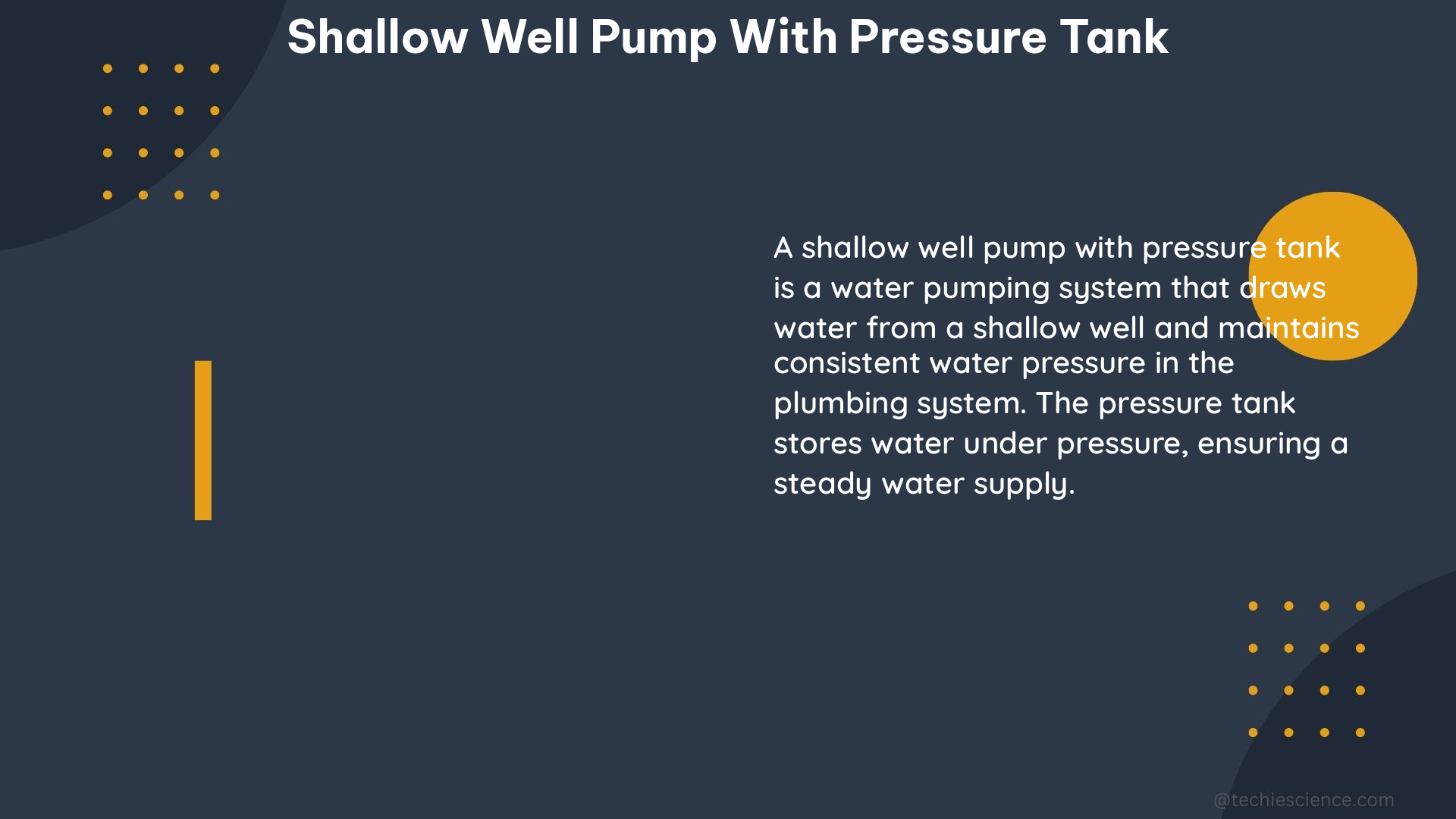Shallow well pumps with pressure tanks are a popular choice for homeowners who rely on groundwater for their water supply. These systems are designed to efficiently draw water from shallow wells and maintain consistent water pressure throughout the home. In this comprehensive guide, we’ll explore the intricacies of shallow well pumps, pressure tanks, and the best practices for selecting and installing these components.
Understanding Shallow Well Pumps
Shallow well pumps are designed to operate in wells that are typically less than 25 feet deep. These pumps are often centrifugal or jet-style, with the pump and motor housed above ground, usually in the basement or a utility room. The pump is connected to the well casing via a suction pipe, which draws water from the well.
The key factors to consider when selecting a shallow well pump include:
- Well Depth: The pump must be capable of lifting water from the well’s depth, typically up to 25 feet.
- Flow Rate: The pump’s flow rate, measured in gallons per minute (GPM), should match the household’s water demand.
- Pressure: The pump must be able to generate enough pressure to deliver water throughout the home’s plumbing system.
- Power Source: Shallow well pumps can be powered by electricity or a gasoline-powered engine, depending on the availability of electrical power.
Pressure Tanks: The Unsung Heroes

Pressure tanks play a crucial role in the operation of a shallow well pump system. These tanks store a reserve of water under pressure, which helps to maintain a consistent water pressure throughout the home. When the water demand increases, the pressure tank releases the stored water, reducing the number of times the pump needs to cycle on and off.
Key considerations when selecting a pressure tank include:
- Tank Size: The tank size should be appropriate for the well’s flow rate and the household’s water demand. A larger tank can help reduce the pump’s cycle rate and extend its lifespan.
- Drawdown: The drawdown is the amount of water the tank can release before the pump needs to refill it. A higher drawdown can provide more consistent water pressure.
- Pressure Settings: The pressure tank should be set to the appropriate pressure range, typically between 40-60 psi, to ensure optimal performance.
- Material: Pressure tanks can be made of various materials, such as steel or composite, each with its own advantages and disadvantages.
Measuring Flow Rate and Pressure
Accurately measuring the flow rate and pressure of a shallow well pump with a pressure tank is crucial for ensuring proper system performance. The stopwatch method, as described in the initial answer, is a simple and effective way to determine the flow rate.
To measure the flow rate:
- Completely drain the system.
- Open the valve to allow water to flow.
- Start the stopwatch as soon as the pump kicks on.
- Let the pump run until it turns off.
- The time it takes for the pump to fill the system is the flow rate in GPM.
To measure the pressure:
- Install a pressure gauge at the pressure tank or the closest accessible point to the tank.
- Monitor the pressure readings during the pump’s operation to ensure it falls within the recommended range.
Optimal Placement and Installation
The placement and installation of the shallow well pump and pressure tank are critical for the system’s performance and longevity. Here are some best practices:
- Proximity to the Well: The pump and pressure tank should be located as close to the well casing as possible, typically within 8 feet, to minimize the suction pipe length and reduce friction losses.
- Elevation: The pump should be installed at a higher elevation than the well casing to prevent water from siphoning back into the well when the pump is turned off.
- Accessibility: The pump and pressure tank should be easily accessible for maintenance and repairs.
- Ventilation: Ensure adequate ventilation around the pump and pressure tank to prevent overheating and ensure proper cooling.
- Electrical Connections: All electrical connections should be made by a licensed electrician to ensure safety and compliance with local codes.
Maintenance and Troubleshooting
Regular maintenance and prompt troubleshooting are essential for the long-term performance and reliability of a shallow well pump with a pressure tank system. Some key maintenance tasks include:
- Pressure Tank Inspection: Regularly check the pressure tank for signs of wear, corrosion, or leaks, and replace the tank if necessary.
- Pump Maintenance: Follow the manufacturer’s recommendations for cleaning, lubricating, and inspecting the pump components.
- Pressure Adjustments: Periodically check and adjust the pressure tank’s settings to maintain the optimal pressure range.
- Leak Detection: Regularly inspect the entire system for any signs of leaks and address them promptly to prevent water waste and potential damage.
By understanding the intricacies of shallow well pumps, pressure tanks, and their proper installation and maintenance, you can ensure a reliable and efficient water supply for your home.
References:
- How to Measure Your Well Pump GPM – YouTube
- Pressure tank Drawdown chart
- Guidance Needed for Shallow Well Set Up – DoItYourself.com
- How Does A Shallow Well Pump Work With A Pressure Tank? – Simple Pump
- Pressure tank and Shallow well pump? – Love Plumbing & Remodel

The lambdageeks.com Core SME Team is a group of experienced subject matter experts from diverse scientific and technical fields including Physics, Chemistry, Technology,Electronics & Electrical Engineering, Automotive, Mechanical Engineering. Our team collaborates to create high-quality, well-researched articles on a wide range of science and technology topics for the lambdageeks.com website.
All Our Senior SME are having more than 7 Years of experience in the respective fields . They are either Working Industry Professionals or assocaited With different Universities. Refer Our Authors Page to get to know About our Core SMEs.